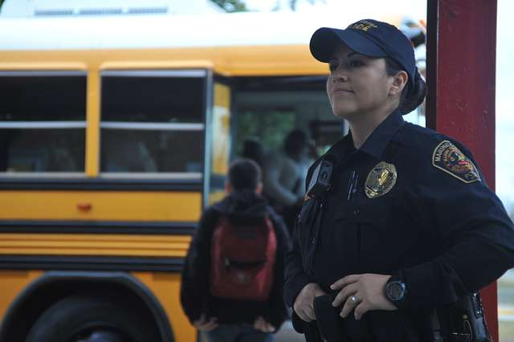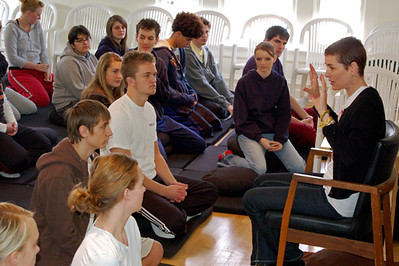Approaches
15 Deliberative Presentations
Learning Objectives
- Explain the role of deliberative presentations in engaging public controversies
- Demonstrate steps in the process of forming a deliberative presentation
- Practice deliberative framing for a deliberative presentation
- Organize a deliberative presentation

The number of US school shootings in recent years has many Americans alarmed and calling for change. But figuring out what should change, how, and who is responsible are difficult questions to answer. Should we tighten security measures at schools? Better drill students and staff for such emergencies? Increase the number of police officers and enhance their training? Decrease classroom sizes? Provide affordable and easy access to mental health services? Stiffen background checks for purchasing guns? Ban assault weapons?
Difficult cases rarely offer one right answer or one universally satisfying way forward. Instead, they raise the need for communities to learn about the problem, possible options, and opposing perspectives before making decisions. In this chapter, we turn to a form of speech that effectively meets that need: deliberative presentations.
In what follows, we first define and explain the deliberative presentation as an especially useful way to address public controversies. We will then explore the five steps involved in preparing a deliberative presentation: (1) selecting a wicked problem, (2) researching the problem, (3) discovering a range of approaches that address the wicked problem, (4) framing an issue for deliberation, and (5) organizing the deliberative presentation.
Deliberative Presentations
A deliberative presentation strives to fairly and evenhandedly describe a civic problem and multiple approaches to solving it. Emphasis is placed on the benefits and drawbacks of each approach. A deliberative presentation functions as the setup or preparation for a deliberative discussion, which is a group conversation through which a community, guided by one or more moderators, examines a complex public problem and a range of available solutions to ultimately arrive at a choice or conclusion. Together, the deliberative presentation and subsequent discussion form the deliberative process (also referred to simply as deliberation). The deliberative process involves a presentation of a problem and multiple options and a subsequent moderated discussion of those options (though the format and timing of both parts can vary).
Box 15.1 The Deliberative Process
|
The Deliberative Process = |
||
|
Deliberative presentation |
+
|
Deliberative discussion |
|
Description of a civic problem and multiple approaches to addressing the problem |
Guided public conversation about the problem and approaches that ends with a choice |
|

The nature and emphasis of the deliberative process is educational. We want to better understand the problem and investigate each solution in the most open manner possible. Note the emphasis on probing and contrasting solutions to the problem, unlike a problem-focused speech.
Indeed, the ultimate end goal—and a key distinguishing feature of the deliberative process—is that the participating community chooses the option it wants to pursue or at least outlines the next steps required. Ideally, the process results in consensus on a way forward, but that may not always be the case. Eventually, traditional persuasive efforts and/or voting may be appropriate.
The deliberative process is ideally suited to address a public controversy, or what others have called a wicked problem—that is, an issue that is difficult to resolve because it involves diverse values and perspectives about what the problem is, who is responsible, and how it should be addressed.[1] A wicked problem is widely acknowledged as a problem and draws broad concern locally, nationally, or even internationally. It may be persistent, such as the issues of gun violence and immigration; or it may become prominent at certain moments and then die down only to resurface again later, such as controversies over oil spills and nuclear power. The point is that wicked problems are never completely resolved; they can only be gradually improved. In contrast, tame problems are simpler issues that can be solved with expertise.
Box 15.2 Wicked Versus Tame Problems
|
Wicked Problems |
Tame Problems |
|
How can we reduce the number of school shootings? |
What is the most effective metal detector? |
|
How should we limit the spread of a health pandemic (COVID-19, etc.)? |
What are risk factors for getting sick? |
|
What should universities do to survive amid increasing costs and competition? |
How does the average increase in tuition at public universities compare with private colleges over the past fifteen years? |
Wicked problems are marked by contingency, a condition in which events and circumstances are dependent on several variables that evolve in unpredictable ways. Thus, the effects of any decision made about a wicked problem cannot be fully anticipated.
Box 15.3 The Contingent Nature of Wicked Problems
What are the answers to these questions about how to end or reduce school shootings?
- Will increasing security at schools lessen school shootings and bring them to an end more quickly? Or will such measures traumatize kids or make them feel like criminals?
- Would stronger background checks for gun ownership and bans on certain weapons decrease shooters’ access to weapons? Or will they leave kids and teachers more vulnerable to attacks?
- Might providing more affordable mental health services steer possible shooters toward more productive outlets? Or will that provision shift necessary funding away from police staffing, training, and protective gear?
We cannot know the answers to questions like these with absolute certainty because too many unpredictable variables influence the outcomes. If we knew the answers with certainty, disagreements and discussion would be unnecessary because the best decision would be self-evident.
Preparing a Deliberative Presentation
The specific steps you should take to prepare a deliberative presentation include selecting a wicked problem, researching the problem, discovering a range of approaches, framing the issue for deliberation, and organizing the presentation. This chapter explain each step, one by one.
Box 15.4 Preparing a Deliberative Presentation
- Select a wicked problem.
- Research the wicked problem.
- Discover a range of approaches that address the wicked problem.
- Frame the wicked problem for deliberation:
- Define the problem fairly.
- Identify the trade-offs of each approach.
- Specify the value(s) that motivate each approach.
- Organize the deliberative presentation.
Selecting a Wicked Problem
Developing a deliberative presentation begins with identifying a wicked problem. Your instinct may be to shy away from difficult issues, particularly those you know little about. This reaction is natural, but try to resist it. Take the initiative to educate yourself. Effective democracies rely on participants who learn and help make decisions about civic matters—and who do not shy away from conflicting viewpoints. In fact, democracy thrives on diverse views and on reasoned, thoughtful discussion. As a student of public communication, learn to embrace productive conflict as a healthy element of democracy. You cannot avoid conflict without also avoiding participation in democratic governance.
Box 15.5 Identifying a Wicked Problem
1. List all the communities of which you are a part: your college, hometown, church, employment, online activity, state, and so on.
a. Think about the problems each group is facing. Write them down.
b. Look over your list. Which of the problems you identified meets the definition of a wicked problem: It is difficult to resolve because it involves diverse values and perspectives about what the problem is, who is responsible, and how it should be addressed.
2. Ask yourself, “What’s important to me? Which issues really matter to me? What is upsetting to me?” Write down your answers.
a. Do other members of your community share these concerns?
b. Which of the problems you identified meets the definition of a wicked problem?
Researching the Wicked Problem

Once you have selected a wicked problem, use the advice provided in chapter 4 to research the issue and to identify and correct misinformation and disinformation—particularly about the problem, its background, impacts, and contributing factors.
Box 15.6 Researching Information About the Wicked Problem of School Shootings
If you focused your deliberative presentation on school shootings, what kinds of information should you find in your research? What would the audience need to know so they could base their opinions on accurate knowledge rather than presumptions, guesses, or misinformation? We would recommend you research the following:
- previous school shootings (how many, their locations, their nature [targeted or as a result of a dispute])
- number of victims
- demographic information about the shooters
- whether and how the number is trending compared to previous years
- past responses to school shootings (by police, medical personnel, legislative bodies, schools and students themselves)
- prevention efforts (such as wellness and security measures taken by schools)
What else might you include?

Factual information alone, however, cannot resolve a wicked problem. You must also consider the people impacted by, and invested in, the issue. In chapter 2, we identified the implicated audience as people affected by your message if it succeeds. We also introduced the concept of personal stakes, which are an individual’s financial, material, and/or psychological investments that can be improved or worsened based on how an issue is addressed. A slight variation on implicated audiences and personal stakes is the idea of stakeholders, or groups and organizations that have vested interests in a wicked problem and its outcome because of the impact on their lives.
Every public issue impacts many different groups, so you should also research multiple stakeholders. Discovering their needs, lived experiences, values, and preferences can help you better understand—and inform your direct audience about—the issue from multiple angles.
Box 15.7 Standpoint Theory
Standpoint theory (Harding, 1991) emerged from feminist philosophy in the 1970s and 1980s to help explain how we gain knowledge and form perspectives.[1] The theory suggests that our standpoint—which is produced by our social identities—influences our knowledge of the world. As philosophy scholar Briana Toole explains, “Knowledge is sensitive to features like your race, your sex, your gender, your sexual orientation, your class, your religious affiliation, and so on.”[2] Our social identities impact how we are perceived and interact with the world. In other words, our social identities play a role in how we are treated, what we are (or are not) encouraged or expected to do, where we can (or cannot) easily go, and where and when we are invited to speak. Those experiences influence what we know.
You might also be a stakeholder yourself in the wicked problem you’ve chosen. If so, reflect on your own experiences and interests to inform your presentation. Relying too much on your own knowledge, however, will likely blind you to aspects of the problem you have never experienced or considered because of your standpoint. Standpoint theory suggests that our social identities influence our knowledge of the world and our perceptions of what is true or normal. In the case of school shootings, for example, our identity is likely to influence our perceptions of shooters, guns, gun violence, and police officers. If you are a white person who lives in a rural setting, for instance, you might be more likely to associate school shootings with troubled kids and associate police officers and guns with offering potential safety and protection.
By researching and discovering additional stakeholders, you will discover not only additional perspectives but also how stakeholders are differently impacted by the wicked problem. Indeed, we recommend you research how inequity plays a role in the wicked problem and who it particularly impacts.
Box 15.8 Researching Stakeholders in the Wicked Problem of School Shootings
 Stakeholders that quickly come to mind for school shootings include students and their families, teachers, and school staff members. You might count yourself among these stakeholders as a student who practiced drills in high school, knows a victim of gun violence, or has experienced gun violence firsthand. Consider what insights you can bring from your experience.
Stakeholders that quickly come to mind for school shootings include students and their families, teachers, and school staff members. You might count yourself among these stakeholders as a student who practiced drills in high school, knows a victim of gun violence, or has experienced gun violence firsthand. Consider what insights you can bring from your experience.
Recognize, however, that not all students (or teachers or families) experience the problem similarly. You will find the following, for example:
- People associated with wealthier, rural, and mostly white-populated schools are more likely to fear school-targeted shootings because they largely occur in those settings.
- Students, teachers, and families associated with urban, poor, and mostly minority student bodies are more likely to fear shootings related to disputes and accidents, which occur more frequently at these settings and much more often than school-targeted shootings. Nearly half (47%) of shootings at K–12 schools from 2009 to 2019 were caused by disputes or accidents; only 14% were “school targeted,” such as in Parkland, Florida. Accordingly, students who are minorities are more likely to be victims of school shootings, yet they are less likely to receive news coverage, since “the most violent (and least common) stories [about school shootings] make the headlines.”
- Recognizing the differences will help you and the direct audience to better identify the issue’s complexity and avoid conflating one stakeholder’s experience with another’s.
Also ask yourself, beyond students, teachers, and their families, who else has a stake in the issue of school shootings and how it’s resolved? You might include the following stakeholders:
- mental health counselors and nurses who aid kids who are traumatized by gun violence or even by practice drills
- community and religious leaders and organizations who strive to help young people resolve grievances without violence
- police officers who are expected to respond swiftly and effectively to anyone inflicting harm on students
- organizations that have a somewhat narrower stake in how the use of guns is addressed, such as reform advocates like Moms Demand Action and rights activists such as the National Rifle Association, not to mention owners of businesses that sell guns and those who promote and teach gun safety
If you pushed yourself even more, you might add stakeholders such as the following:
- legislators who provide school funding, hold police forces accountable, and pass laws that govern gun rights
- news media reporters who make decisions about how to report school shootings
Your thinking about stakeholders should not result in telling your audience a laundry list of groups. Instead, use this work to clarify for your audience how the wicked problem differently affects the lives and interests of diverse groups and thus why their preferences might conflict. For instance, include examples of differing stakeholders when educating your audience about the wicked problem. As you discover and explain diverse approaches to the problem—a task we turn to next—specify which stakeholders are benefited and harmed by each approach and how.
Discovering a Range of Approaches
Once you have selected a wicked problem and researched its elements and stakeholders, identify a range of approaches to improving the issue. As discussed in chapter 2, we tend to divide issues into two sides, often “for” a policy change and “against” it. This binary approach is popular, but it reduces complicated issues to tidy, oppositional dichotomies as if everyone on each side is in complete agreement and no one from opposing sides agrees on anything.
Box 15.9 Avoid Two Opposing Approaches to the Wicked Problem
The issue of school shootings can easily become a two-sided debate over gun regulation. People are identified as being either
|
for |
or |
against gun regulation |
|
|
which is assumed to mean |
|
|
total prohibition of guns |
vs. |
unrestricted gun access |
Of course, few people hold such extreme views either way. Generally speaking,
- those in favor of gun regulation do not propose that all guns be removed or banned from law-abiding citizens, and
- those against gun regulation are not in support of all persons having unlimited access to all types of weapons.
When we oversimplify positions as one extreme or another, we tend to lose sight of our common problem: “How do we best ensure our children’s safety?” We also overlook more moderate and nuanced options. These could range from waiting periods and increased background checks and registration to “red flag” laws, permits, and legislation based on factors like age, criminal record, or intellectual ability.
Try to avoid getting caught up in two-sided policy debates. Do not make two of your approaches the extremes in a debate and the third approach a halfway measure or compromise between them. Such a setup prompts a debate rather than a deliberation, or it encourages most participants to choose the third option.
Instead, seek a much wider range of approaches. As box 15.10 advises, brainstorming, considering stakeholders’ interests, and researching will help you find suitable and diverse approaches. You might, for instance, discover how inequity or systems of oppression contribute to the wicked problem and focus one approach on targeting such inequity.
Box 15.10 Discovering at Least Three Approaches to a Wicked Problem
The challenge of discovering at least three approaches for a deliberative presentation can be overcome by following a few tips:
- Brainstorm: Write down all the pertinent beliefs, opinions, and specific public actions that come to mind. You can even imagine additional approaches or possible actions that others may not have considered.
- Consider stakeholders: Return to the research you conducted on the stakeholders in this controversy. What policies and approaches did each advocate? Consider interviewing several key stakeholders to learn more about their experiences, perspectives, and preferred approaches.
- Research the issue: Focus particularly on sources that express public opinions and perspectives, such as letters to the editor or opinion editorials, news interviews, YouTube videos, podcasts, blogs, websites devoted to advocating a group’s perspective, and opinion polls.
As you gather perspectives, preferences, and policy ideas, refrain from evaluating their merit. The sole criterion is that all ideas listed are reasonable. Options that no one in their right mind would choose are not useful for a deliberative presentation.
Then look for repetition or similarities across the ideas so you can sort them into three approaches to present to your audience. By approach we mean a broad category of similar opinions on how to address a wicked problem, typically gathered around a shared logic and value. A single approach should be broad enough to include several, and possibly conflicting, actions by multiple actors.
Box 15.11 Sample Approaches to the Wicked Problem of School Shootings

1. Adopt stronger security efforts, with the logic that if it is more difficult to bring or hide a gun on school property, there will be fewer shootings there.
Specific sample actions: Restrict kids to carrying clear backpacks, use metal detectors at entrances, and hire more on-site security officers.
People who like this approach would agree with the overall emphasis on security, but they might disagree with each other over which policy options should be chosen.

2. Improve youth wellness. Such an approach poses the logic that if communities know and attend to young people’s emotional and psychological needs better, then they will be less likely to resort to shooting each other.
Specific sample actions: Incorporate daily meditation practices into classrooms, hire more school counselors, offer training in dispute reconciliation, fund community centers, and strengthen family involvement.
All these ideas are included in one approach because they emphasize youths’ mental health and wellness, though people attracted to this approach might disagree on which specific policy ideas will be most effective.
3. What might be a third broad approach?
Rest assured there is no one right set of three approaches for any wicked problem, and you might even want to present four or five. Your goal is simply to provide a set of truly divergent approaches that account for most, if not all, of the concerns and opinions you discovered about the wicked problem. Everyone in the community who hears your deliberative presentation should be able to find their own outlook somewhere in the approaches you provide. The next step is to frame the wicked problem for deliberation.
Framing
Framing refers to the use of language to order and make sense of the world. That is, framing is how we employ language to help shape perceptions of reality. Consequently, you should be conscious of the language you employ when discussing public issues. For any complex and controversial social issue, your words can influence what an audience notices and thinks about, as well as what they overlook or downplay, when drawing conclusions.
The framing of any civic issue typically consists of three parts: It identifies or defines the problem (i.e., what’s wrong), its cause (i.e., who’s to blame), and the solution (i.e., what should be done). Every issue-specific frame includes—and typically promotes—these three elements, whether they are explicitly stated or merely implied.
You can use framing strategically when trying to persuade an audience, but framing for deliberation should strive for neutrality and fairness. We’ll explain this distinction next.
Box 15.12 Framing as a Rhetorical Concept

To better understand framing, consider a more typical use of the word. Think about the frames you use to border pictures or pieces of artwork. The size, color, and pattern of a frame can influence what you see or notice in the picture or art itself. Also, choosing what parts of a picture to include inside the frame and what parts to exclude (or crop out) significantly affects what viewers see and notice in the resulting framed image. Discursive framing (i.e., frames created by language) functions similarly.
Persuasive Framing
Different people will frame the same issue differently. Many of our disagreements result from conflicting frames for the same issue. Persuasive framing, then, occurs when a speaker strategically names or defines an issue in a way that sets up their desired outcome as effective and reasonable. Box 15.13 provides examples. Persuasive framing also typically involves stressing the advantages of the speaker’s preferred solution and downplaying or ignoring its drawbacks. We will further explore this type of framing in chapter 18 when we discuss persuasion.
Box 15.13 Sample Persuasive Framing
When it comes to illegal immigration, speakers’ language choices often signify their persuasive framing of the issue. For example, compare two different uses of language to describe unlawful immigration:
- “Illegal aliens” points to immigration as the problem, blames the immigrants for entering the country unlawfully, and typically promotes the solutions of deportation and securing our borders.
- “Undocumented workers” or “unauthorized immigrants” implies the problem is the lack of proper documentation or authorization (such as a certificate of citizenship), blames the long delays and significant costs immigrants face when applying for legal US citizenship, and typically promotes the solution of legislative reform to the citizenship process.
Notice how the problem, cause, and solutions identified in both frames correspond with each other; they compose an internal logic or coherent point of view.
Deliberative Framing
Since deliberative presentations are primarily informative rather than persuasive, a speaker must establish the problem and possible solutions as clearly and neutrally as possible. Deliberative framing, then, occurs when a speaker names or defines the issue in a way all parties can agree upon and encourages the fair and direct comparison of approaches. By adopting deliberative framing, you enhance the audience’s ability to make a group decision about how best to move forward.
Deliberative framing can be tricky, however, because each of the approaches you explore likely offers its own persuasive framing that defines the problem in a way that leads the audience to its preferred solution. Avoid adopting persuasive framings so you can encourage the public to consider more than one way of solving the problem.
How do you do that? We now turn to the work required to successfully frame a wicked problem for deliberation: define the problem fairly, identify the trade-offs of each approach, and specify the value or values that motivate each option.
Defining the Problem Fairly
It is critical that you define the wicked problem fairly; otherwise, the language you use can bias the audience in favor of one of the approaches. To depict the problem fairly, we recommend you adopt a common definition, phrase the problem as a “how” or “what” question, and avoid language used by proponents of any one approach.
First, find a common definition of the problem that all interested parties can agree upon—one that identifies the core issue all the approaches are trying to solve. To do so, you typically want to articulate the problem at a greater level of abstraction or generality than the definition offered by any one of the groups involved. That means presenting the problem as bigger than any specific actor (person, group, organization, or institution) or action. Doing so captures the ultimate focus of all interested parties, invites a variety of perspectives to be expressed, and enables a community to compare them more easily.
Second, phrase the problem as a “how” or “what” question, because these questions invite multiple answers. Avoid using “should,” “does,” or “is” to begin your question because they invite only two sides (for and against, or yes and no).
Finally, avoid language that is used by advocates for any one approach or else the conversation will unfairly favor that preference and unhelpfully narrow the issue. Box 15.14 offers an example of a problem definition that follows these suggestions.
By following these guidelines for defining the problem, no one cause of the problem is stated or clearly implied. Instead, any number of causes could—and should—be identified, revealing the complexity of the wicked problem and opening the door to numerous solutions or approaches as reasonable.
Box 15.14 Defining the Problem for a Deliberative Conversation About School Shootings
To help explain how to define the problem fairly for deliberative framing, let’s take the wicked problem of school shootings. Compare the following appropriate and inappropriate ways of defining the problem and asking about the problem.
Defining the Problem of School Shootings
|
How Should We Define the Problem of School Shootings? |
||
|
YES: Deliberative |
NO: Persuasive |
NO: Persuasive |
|
“incidents where one or more people are injured or killed by a firearm on school grounds” |
“the exploitation of soft targets” |
“the desperate actions of depressed individuals who don’t respond well to life’s stressors” |
|
|
|
Phrasing the Problem as a Question
|
YES: Fair and open-ended |
NO: Overly narrow |
NO: Biased |
|
“How can we best reduce the number of school shootings?” |
“Should schools hire more security officers?” |
“How can we stop people from using military assault weapons to kill schoolchildren?” |
|
“What should we do to decrease school shootings?” |
“Is it acceptable for a school to search students’ backpacks?” |
“How can we stop school shootings without restricting gun ownership?” |
Identifying Trade-Offs
In addition to defining the problem fairly, deliberative framing requires you to identify the trade-offs of every approach. Trade-offs are the relative advantages and disadvantages that accompany every approach to a wicked problem. Each solution offers certain benefits and drawbacks, prioritizes some people’s needs and neglects or diminishes others, and poses challenges for implementation. Making wise choices requires understanding the drawbacks to each approach as well as the benefits.
The emphasis on trade-offs contrasts with persuasive framing, which typically only stresses the advantages of the speaker’s preferred solution. Deliberative framing encourages us instead to comprehend that every wicked problem has multiple sides and no magic solution exists—one choice that stands out as the most obvious, that defeats the opposing views, or that will result in 100% agreement.
Box 15.15 Discovering the Trade-Offs of Each Approach
To discover trade-offs, answer the following questions by going back through your research and thinking on your own:
1. What are the benefits of this approach?
-
- What advantages are gained?
- Which stakeholders benefit from this approach, or whose needs are prioritized by this approach?
2. What are the drawbacks of this approach?
-
- What disadvantages are incurred?
- Which stakeholders are hurt by this approach, or whose needs are neglected or devalued?*
3. What challenges might arise when implementing this approach?
Recognize that a single approach can simultaneously benefit one stakeholder while hurting another.
Example: Returning to the example of school shootings, we can predict that increasing the frequency and realism of security drills at schools would likely mitigate the damage and end a shooting more quickly.
But…
It would simultaneously scare children who experience the drills as if they were real, which could decrease their ability to learn and flourish.
Weighing Competing Values
Further frame your topic for deliberation by identifying the value or set of values that motivates each approach. A value refers to a principle or quality that human beings are committed to and on which they base their thinking and decisions for important issues. Values tend to be central to our self-identity and to our community’s identity.
To understand more clearly how values function in public controversies, we need to establish several principles: (1) we agree generally upon the attraction of basic values, (2) our value hierarchies typically shift from issue to issue and sometimes from case to case, and (3) even when we agree to prioritize the same value for a specific case, we may define or apply the value differently. Let’s briefly explore each principle.
1. We agree generally upon the attraction of basic values, such as loyalty, freedom, and equality. Speakers, however, often imply they support a value (freedom, for instance) while their opponent does not. That is rarely the case.
- Instead, though we agree on most values, we rank them differently. A value hierarchy is a list of values ranked from the most to the least important.
Example: If you and another person create a value hierarchy for equality, responsibility, freedom, family, cooperation, and creativity, you might each, for your own reasons, designate distinct orders. If that occurs with a group of just six values, imagine how much you would diverge when ranking a significantly larger number of the hundreds of values that exist!
- When you and another person prioritize different values, a value dilemma emerges. A value dilemma represents a difficult choice among competing values, especially those associated with policy options.
Box 15.16 The Value Dilemma over the School Shooting in Parkland, Florida

On February 14, 2018, Nikolas Cruz walked into his former school, Marjory Stoneman Douglas High School, in Parkland, Florida, and began shooting. He killed seventeen people and wounded fourteen more. Reactions to this horrific incident reveal the value dilemma it presented as stakeholders prioritized diverse values to address it.
- Security: Scot Peterson, the sheriff’s deputy assigned to protect the school, did not enter the school building during the six-minute massacre. He was charged with (but later acquitted for) child neglect and culpable negligence because of his alleged failure to provide security for the kids.
- Life: Cruz used an AR-15-style semiautomatic weapon to murder classmates. About a month later, on March 24, 2018, survivors of the shooting organized March for Our Lives to protest gun violence and demand legislators pass gun control measures. Florida representatives responded by raising the age required to buy firearms in Florida and passing a “red flag” law to remove guns from potential threats.
- Freedom: The National Rifle Association sued Florida, saying the increased age requirement to own a gun violated the freedom granted in the Second and Fourteenth Amendments of the United States Constitution. President Trump made similar comments and called to arm teachers with firearms instead.
- Health: Cruz suffered from depression, attention-deficit/hyperactivity disorder, and autism, leading Trump to comment on Cruz’s mental health. Florida’s legislature increased funding for mental health assistance at schools.
What do you think? Which value(s) would you prioritize to address a US school shooting? How does that choice impact the other values listed here? What other current wicked problems are creating tensions between multiple values?
2. Our value hierarchies typically shift from issue to issue and sometimes from case to case. Changing your value hierarchy does not mean you lack principles or consistency. It simply means you recognize the contingent nature of public controversies.
Example 1: A person who prioritizes “life” in the abortion controversy (and thus opposes most or all abortions) might prioritize justice over life in the case of capital punishment (and thus favor the death penalty even though it means terminating a life).
Example 2: Someone who generally favors capital punishment might oppose it when the criminal has an intellectual disability or is underage, thereby placing fairness (in that these criminals cannot be held fully responsible for their actions) over justice.
3. Even when we agree to prioritize the same value for a specific case, we may define or apply the value differently. Therefore, a speaker should not merely name the value prioritized by an approach but explain how it is defined and applied to the problem.
Example: Regarding school shootings, many people argue that safety is important. But what is considered “safe”? Arming teachers sounds to some like it will increase safety. That same action to others, however, sounds unsafe because of the increased likelihood of accidental shootings and the possible differential treatment by police toward Black teachers who carry a weapon compared to white teachers.
In sum, value dilemmas play a critical role in our conflicts, but too often rhetors speak in ways that hide or simplify them. Part of your job is to help your audience recognize, understand, and ultimately discuss the value dilemmas that undergird their disagreements. Doing so will provide the foundation they need to understand their conflicts and find creative ways to move forward together. But how can you present your findings and information in ways that facilitate such progress? We turn next to the final step of preparing a deliberative presentation.
Organizing the Deliberative Presentation
For your presentation to serve its purpose, it must also be clearly organized. Refer to chapter 7 to recall why clear organization is important, how to organize main points, and how to develop an introduction, conclusion, and transitions.
Here we will suggest ways to tailor an introduction, main points, and conclusion for a deliberative presentation. In addition to an attention-getter, the introduction might include a central idea (rather than a thesis statement) that names the wicked problem as the presentation’s focus. Phrasing the problem as a question can be particularly useful here. Your introduction might also include a preview statement that indicates the main points or sections.
You may find it useful to structure your main points using the problem-alternatives-solution pattern of arrangement discussed in chapter 7 without the solution step included. That means the body of a deliberative presentation could include four main points:
- one main point that explains the problem and
- a main point devoted to each of the three approaches explained. These are the options or alternatives offered for the audience to compare and contrast.
- Notice there is no main point focused on a preferred solution, since that would make the speech persuasive rather than deliberative in nature.
The main points devoted to the approaches could explain the logic of each approach in addressing the problem, its benefits and drawbacks, and the value(s) it prioritizes.
You can conclude by restating the wicked problem and three perspectives and inviting the audience to engage the information you provided through a deliberative discussion.
Box 15.17 Deliberative Presentation Media
A deliberative presentation can be delivered through at least three different media:
- A speech delivered by an individual or group of people. Often the same person or people who deliver the speech then function as moderators of the deliberative discussion (discussed in the next chapter).
- A short film or video. A video can more easily humanize the issue by including video clips of people affected by the problem and/or people voicing support for each of the approaches.
- A written booklet. The National Issues Forum has made what it (and now others) call “issue books” popular. Such booklets are typically concise, yet dense, explanations of a wicked problem and three approaches, though their precise format varies.
Of course, a deliberative presentation can be delivered with two or more of the media listed. Some deliberation practitioners, for instance, provide an issue book to the public in advance of a deliberative discussion and then show a short video right before the discussion to remind them of the options and to educate anyone who did not read the booklet.
Conclusion
In a deliberative presentation, the speaker strives to fairly and evenhandedly describe a wicked problem and multiple approaches to solving the problem. Ultimately, creating a deliberative presentation using the five steps outlined in this chapter will help you prepare an audience for a deliberative discussion in which participants examine the problem and approaches to ultimately decide, together, how best to address the issue. A successful deliberative presentation in any form helps create an environment in which participants are able and willing to listen to each other.
- Brian W. Head identifies Horst Rittel and Mel Webber as originating the term wicked problem in 1973. See Brian W. Head, Wicked Problems in Public Policy: Understanding and Responding to Complex Challenges (Palgrave Macmillan, 2022). Open access CC 4.0 license. ↵

